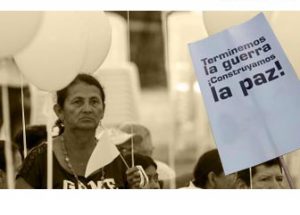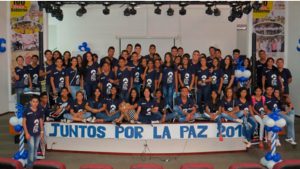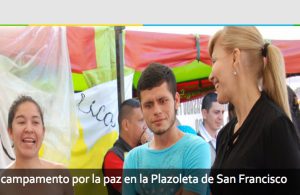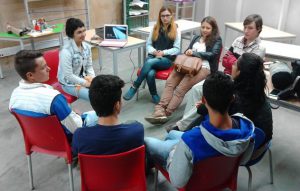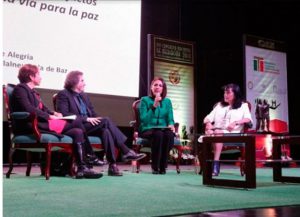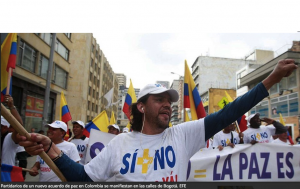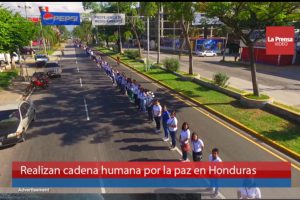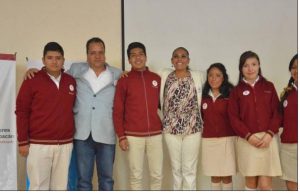FREE FLOW OF INFORMATION
Excerpts from the lecture published by the official website of the Nobel Prize, presented in Oslo, 10 December 2016.
Six years ago, it was hard for we Colombians to imagine an end to a war that had lasted half a century. To the great majority of us, peace seemed an impossible dream – and for good reason. Very few of us – hardly anybody – could recall a memory of a country at peace.
Today, after six years of serious and often intense, difficult negotiations, I stand before you and the world and announce with deep humility and gratitude that the Colombian people, with assistance from our friends around the world, are turning the impossible into the possible. . . .
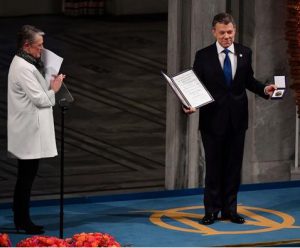
With this agreement, we can say that the American continent – from Alaska to Patagonia – is a land in peace.
And we can now ask the bold question: if war can come to an end in one hemisphere, why not one day in both hemispheres? Perhaps more than ever before, we can now dare to imagine a world without war.
The impossible is becoming possible. . . .
I have served as a leader in times of war – to defend the freedom and the rights of the Colombian people – and I have served as a leader in times of making peace.
Allow me to tell you, from my own experience, that it is much harder to make peace than to wage war.
When it is absolutely necessary, we must be prepared to fight, and it was my duty – as Defence Minister and as President – to fight illegal armed groups in my country.
When the roads to peace were closed, I fought these groups with effectiveness and determination
But it is foolish to believe that the end of any conflict must be the elimination of the enemy.
A final victory through force, when nonviolent alternatives exist, is none other than the defeat of the human spirit.
Seeking victory through force alone, pursuing the utter destruction of the enemy, waging war to the last breath, means failing to recognize your opponent as a human being like yourself, someone with whom you can hold a dialogue with.
Dialogue…based on respect for the dignity of all. That was our recourse in Colombia. And that is why I have the honour to be here today, sharing what we have learned through our hard-won experience.
Our first and most vital step was to cease thinking of the guerrillas as our bitter enemies, and to see them instead simply as adversaries. . .
A few lessons can be learned from Colombia’s peace process and I would like to share them with the world:
You must properly prepare yourself and seek advice, studying the failures of peace attempts in your own country and learning from other peace processes, their successes and their problems.
The agenda for the negotiation should be focussed and specific, aimed at solving the issues directly related to the armed conflict, rather than attempting to address all the problems faced by the nation.
Negotiations should be carried out with discretion and confidentiality in order to prevent them from turning into a media circus.
Sometimes it is necessary to both fight and talk at the same time if you want to arrive at peace – a lesson I took from another Nobel laureate, Yitzhak Rabin.
You must also be willing to make difficult, bold and oftentimes unpopular decisions in order to reach your final goal.
In my case, this meant reaching out to the governments of neighbouring countries with whom I had and continue to have deep ideological differences.
(Click here for a Spanish version of the speech)
(Continued in right column)
What is happening in Colombia, Is peace possible?
(Continued from left column)
Regional support is indispensable in the political resolution of any asymmetric war. Fortunately, today all the countries in the region are allies in the search for peace, the noblest purpose any society can have.
We also achieved a very important objective: agreement on a model of transitional justice that enables us to secure a maximum of justice without sacrificing peace.
I have no doubt this model will be one of the greatest legacies of the Colombian peace process. . . .
And I feel that I must take this opportunity to reiterate the call I have been making to the world since the Summit of the Americas in Cartagena in 2012, which led to a special session of the General Assembly of the United Nations in April this year.
I am referring to the urgent need to rethink the world War on Drugs, a war where Colombia has been the country that has paid the highest cost in deaths and sacrifices.
We have moral authority to state that, after decades of fighting against drug trafficking, the world has still been unable to control this scourge that fuels violence and corruption throughout our global community.
The peace agreement with the FARC includes their commitment to cut all ties with the drug business, and to actively contribute to fighting it.
But drug trafficking is a global problem that demands a global solution resulting from an undeniable reality: The War on Drugs has not been won, and is not being won.
It makes no sense to imprison a peasant who grows marijuana, when nowadays, for example, its cultivation and use are legal in eight states of the United States.
The manner in which this war against drugs is being waged is equally or perhaps even more harmful than all the wars the world is fighting today, combined. It is time to change our strategy. . .
In Colombia, we have also been inspired by the initiatives of Malala, the youngest Nobel Laureate, because we know that only by developing minds, through education, can we transform reality.
We are the result of our thoughts; the thoughts that create our words; the words that shape our actions.
That is why we must change from within. We must replace the culture of violence with a culture of peace and coexistence; we must change the culture of exclusion into a culture of inclusion and tolerance. . . .
In a world where citizens are making the most crucial decisions – for themselves and for their nations – out of fear and despair, we must make the certainty of hope possible.
In a world where wars and conflicts are fuelled by hatred and prejudice, we must find the path of forgiveness and reconciliation.
In a world where borders are increasingly closed to immigrants, where minorities are attacked and people deemed different are excluded, we must be able to coexist with diversity and appreciate the way it can enrich our societies.
We are human beings after all. For those of us who are believers, we are all God’s children. We are part of this magnificent adventure of being alive and populating this planet.
At our core, there are no inherent differences: not the colour of our skin; nor our religious beliefs; nor our political ideologies, nor our sexual preferences. All these are simply facets of humanity’s diversity.
Let’s awaken the creative capacity for goodness, for building peace, that live within each soul.
In the end, we are one people and one race; of every colour, of every belief, of every preference.
The name of this one people is the world. The name of this one race is humanity.
If we truly understand this, if we make it part of our individual and collective awareness, then we will cut the very root of conflicts and wars.
In 1982 – 34 years ago – the efforts to find peace through dialogue began in Colombia.
That same year, in Stockholm, Gabriel García Márquez, who was my ally in the pursuit of peace, received the Nobel Prize in Literature, and spoke about “a new and sweeping utopia of life, (…) where the races condemned to one hundred years of solitude will have, at last and forever, a second opportunity on earth.”
Today, Colombia – my beloved country – is living that second opportunity; and I thank you, members of the Norwegian Nobel Committee, because, on this occasion, you have not only awarded a prize to peace: you helped make it possible!
The sun of peace finally shines in the heavens of Colombia.
May its light shine upon the whole world!
